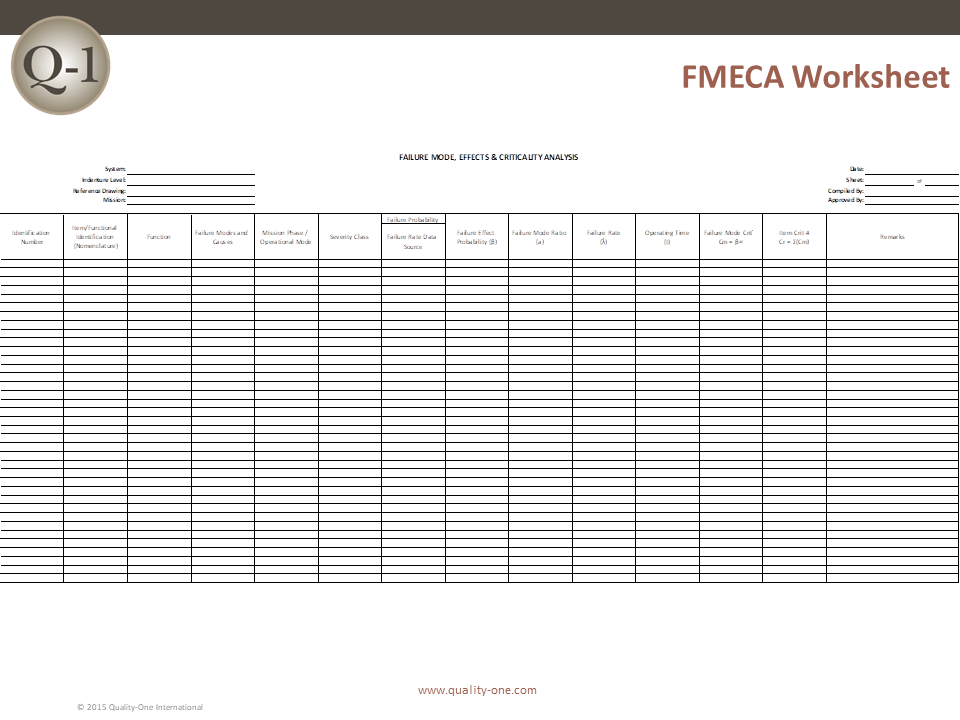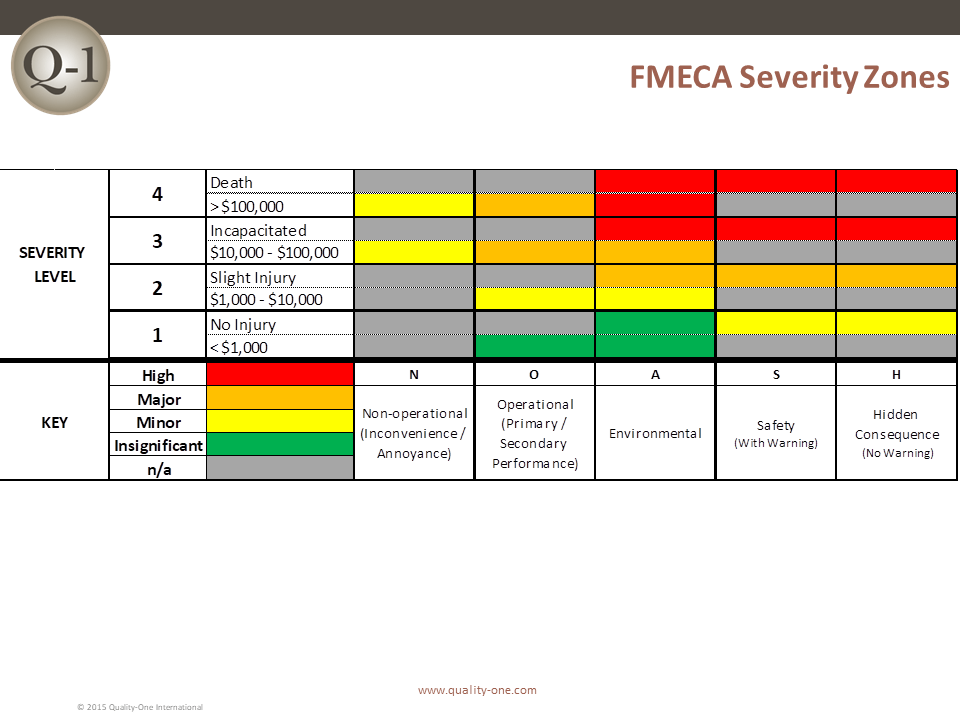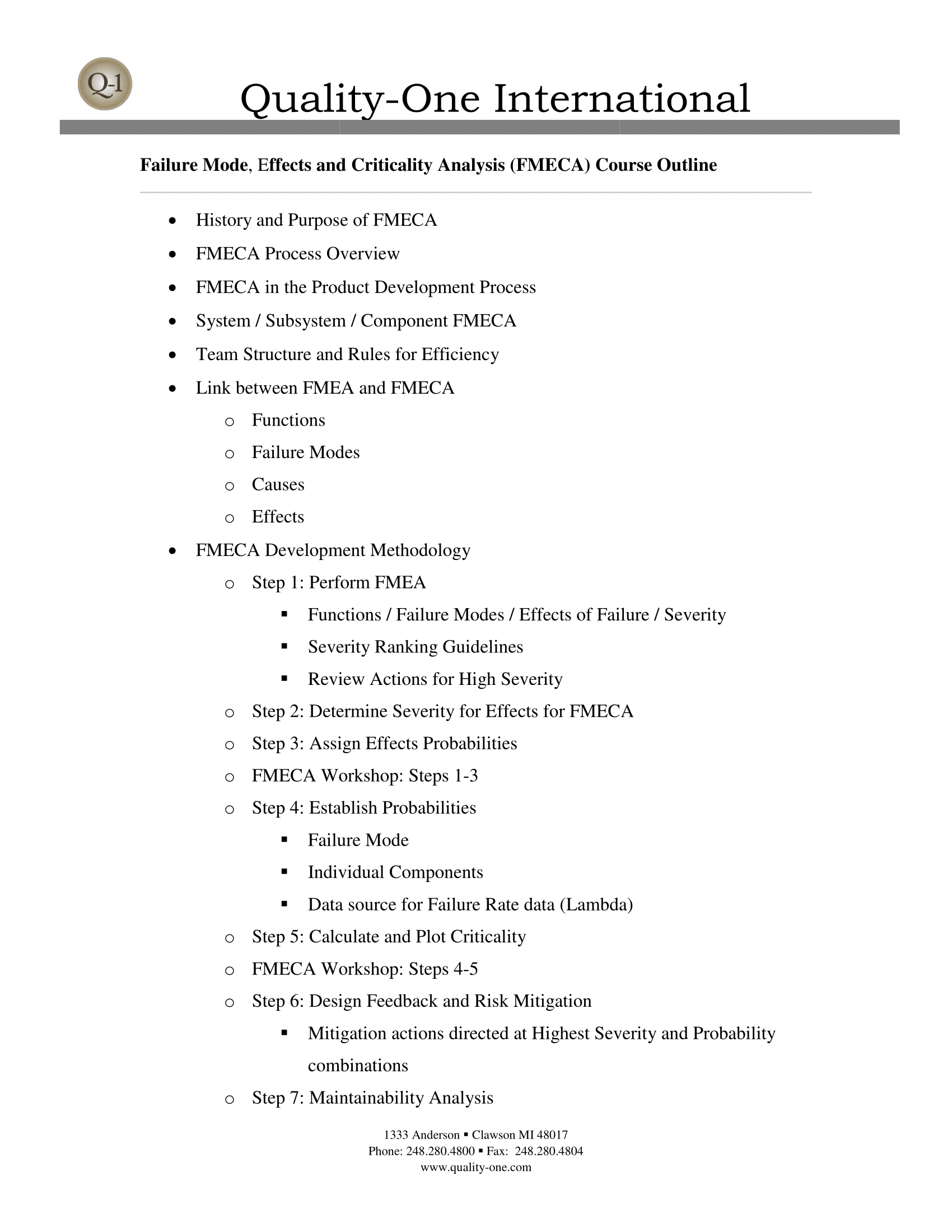FMECA
– Failure Mode, Effects & Criticality Analysis –

Introduction to Failure Mode, Effects & Criticality Analysis (FMECA)
In the late 1940s, the US military was committed to change from an approach of “find failure and fix it” to “anticipate failure and prevent it”. The methods developed focused on qualitative and quantitative risk identification for preventing failure. Failure Mode, Effects & Criticality Analysis (FMECA) is a method which involves quantitative failure analysis. The FMECA involves creating a series of linkages between potential failures (Failure Modes), the impact on the mission (Effects) and the causes of the failure (Causes and Mechanisms). The methods and techniques associated with the FMECA were published in a series of Military Standards. MIL-STD-1629A is the most prominent of these standards and is still in use today.
What is Failure Mode, Effects & Criticality Analysis (FMECA)
FMECA is a bottom-up (Hardware) or top-down (Functional) approach to risk assessment. It is inductive, or data-driven, linking elements of a failure chain as follows: Effect of Failure, Failure Mode and Causes/Mechanisms. These elements closely resemble the modern 5 Why technique in Root Cause Analysis (RCA). The Effect of Failure duplicates the experience of a user/customer and is then translated into the technical failure description or Failure Mode. The technical failure description answers the next question “Why”, introducing causes that result in the failure mode. Each failure mode has a probability assigned and each cause has a failure rate assigned. If data is not available, probability of occurrence is assigned. The probability depends on the failure data source documents utilized in the FMECA. Unlike 5 Why, the FMECA is performed prior to any failure actually occurring. FMECA analyzes risk, which is measured by criticality (the combination of severity and probability), to take action and thus provide an opportunity to reduce the possibility of failure.
FMECA and Failure Mode and Effects Analysis (FMEA) are closely related tools. Each tool resolves to identify failure modes which may potentially cause product or process failure. FMEA is qualitative, exploring “what-if scenarios”, where FMECA includes a degree of quantitative input taken from a source of known failure rates. A source for such data is Military Handbook 217 or equivalent.
There are two activities to perform FMECA:
- Create the FMEA
- Perform the Criticality Analysis
Measured criticality is the intersection of severity and cause probability rankings. Results are depicted in four primary criticality zones. Criticality is used to determine product or process design weaknesses. Two quantitative and one qualitative options exist for FMECA Criticality as identified below:
- Quantitative
- Mode Criticality = Item Unreliability x Mode Ratio of Unreliability x Probability of Loss x Time (life)
- Item Criticality = Sum of Mode Criticalities
- Qualitative
- Compare failure modes via a Criticality Matrix, which identifies severity on the horizontal axis and qualitatively derived occurrence on the vertical axis
- Note: Quality-One suggests a qualitative criticality matrix for the Quality-One Three Path Model for FMEA Development. Severity is on the vertical axis and occurrence is depicted on the horizontal axis. This is often used as an alternative for the Risk Priority Number (RPN) in FMEA.
Why Perform Failure Mode, Effects & Criticality Analysis (FMECA)
The intent of the Failure Mode, Effects & Criticality Analysis methodology is to increase knowledge of risk and prevent failure. The tangible benefits of FMECA are offered in the following categories:
Design and Development Benefits
- Increased reliability
- Better quality
- Higher safety margins
- Decreased development time and re-design
Operations Benefits
- More effective Control Plans
- Improved Verification and Validation testing requirements
- Optimized preventive and predictive maintenance
- Reliability growth analysis during product development
- Decreased waste and non-value added operations (Lean Operation and Manufacturing)
Cost Benefits
- Recognize failure modes in advance (when they are less costly to address)
- Minimized warranty costs
- Increased sales from customer satisfaction
How to Perform Failure Mode, Effects & Criticality Analysis (FMECA)
The basic assumption when performing FMECA instead of FMEA is the desire to have a more quantitative risk determination. The FMEA utilizes a more multi-functional team using guidelines to set Severity and Occurrence. The FMECA is performed by first completing an FMEA process worksheet and then completing the FMECA Criticality Worksheet.
The general steps for FMECA development are as follows:
- FMEA Portion (see our FMEA page for more details)
- Define the system
- Define ground rules and assumptions to help drive the design
- Construct system Boundary Diagrams and Parameter Diagrams
- Identify failure modes
- Analyze failure effects
- Determine causes of the failure modes
- Feed results back into design process
- FMECA Portion
- Transfer Information from the FMEA to the FMECA
- Classify the failure effects by severity (change to FMECA severity)
- Perform criticality calculations
- Rank failure mode criticality and determine highest risk items
- Take mitigation actions and document the remaining risk with rationale
- Follow-up on corrective action implementation/effectiveness
FMECA can often become time consuming and therefore available resources and team interest can be an issue as the process continues. Quality-One has developed the FMECA process below to utilize engineering resources effectively and ensure the FMECA has been developed thoroughly. The Quality-One approach is as follows:
Step 1: Perform the FMEA
The FMEA is a good starting place for the FMECA. FMEA allows for qualitative, and therefore creative, inputs from a multi-disciplined engineering team. FMEA provides the first inputs into design change and can jump start the risk mitigation process. The FMEA information is transferred into the FMECA Criticality Worksheet. The transferred data from the FMEA worksheet will include:
- Item Identification Number
- Item / Function
- Detailed Function and / or Requirements
- Failure Modes and Causes with Mechanisms of Failure
- Mission Phase or Operational Mode (DoD specific), often related to the Effects of Failure
Step 2: Determine Severity Level
Next, assign the Severity Level of each Effect of Failure. There are various severity tables to select from. The following is used in medical and some aerospace activities. The actual descriptions can be altered to fit any product or process design. There are generally four severity level classifications as follows:
- Catastrophic: Could result in death, permanent total disability, loss exceeding $1M, or irreversible severe environmental damage that violates law or regulation
- Major/High Impact: Permanent partial disability, injuries or occupational illness resulting in hospitalization of 3 or more personnel, loss exceeding $200K but less than $1M, or reversible environmental damage causing a violation of law or regulation
- Minor Impact: Could result in injury or occupational illness resulting in one or more lost work day(s), loss exceeding $10K but less than $200K, or mitigatable environmental damage without violation of law or regulation where restoration activities can be accomplished
- Low Impact: Result in minor injury or illness not resulting in a lost work day, loss exceeding $2K but less than $10K, or minimal environmental damage
Step 3: Failure Effect Probability
In some applications of FMECA, a Beta value is assigned to the Failure Effect Probability. The FMECA analyst may also use engineering judgement to determine the Beta value. The Beta / Effect Probability is placed in the FMECA Criticality Worksheet where:
- Actual Loss / 1.00
- Probable loss / >0.10 to <1.00
- Possible loss / >0 to =0.10
- No Effect / 0
A failure mode ratio is developed by assigning a proportion of the failure mode to each cause. The accumulation of all cause values equals 1.00.
Step 4: Probability of Occurrence (Quantitative)
Assign probability values for each Failure Mode, referencing the data source selected. Failure Probability and Failure Rate data can be found from several sources:
- Handbook 217 is referenced but any source of failure rate data can be used
- RAC databases, Concordia, etc.
If the Failure Mode probability is listed (functional approach) several columns of the FMECA Criticality Worksheet may be skipped. Criticality (Cr) can be calculated directly. When failure rates for failure modes and contributing components are desired, detailed failure rates for each component are assigned.
Next, we must assign Component Failure Rate (lambda). Failure Rates for each component are selected from the failure rate source document. Where there is no failure rate available, the qualitative values from the FMEA are used. FMEA may also be an alternative method on new or innovative designs.
Operating Time (t) represents the time or cycles the item or component will be expected to live. This is related to the expected duty cycle requirements.
Step 5: Calculate and Plot Criticality
In FMECA, Criticality is calculated in two ways:
- The Modal Criticality (each failure mode all causes) = Cm
- The Criticality of the Item (all failure modes summarized) = Cr
Formulas of each are not provided in this explanation but the essence of the elements of the calculation is as follows:
- Cm = The product of the following:
- Failure Rate of the Part (lambda)
- Failure Rate of the Effect (Beta)
- Failure Mode Ratio (alpha)
- Operating Time (units of time or cycles)
- Cr = The summation of all the Cm
Step 6: Design Feedback and Risk Mitigation
Risk mitigation is a discipline required to reduce possible failure. The identified risk in the criticality matrix is the substitute for failure and must be treated in the same context as a test failure or customer returned component or item. FMECA requires a change in risk levels / criticality after mitigation. A defect / defective detection strategy, commensurate to the risk level, may be required. Acceptable risk management strategy includes the following:
- Mitigation actions directed at Highest Severity and Probability combinations
- Any risk where mitigation was unsuccessful is a candidate for Mistake Proofing or Quality Control, protecting the customer / consumer from the potential failure
- Detection methods are chosen for failure modes first and if possible individual causes which do not permit shipping or acceptance
- Action logs and “risk registers” with revision history are kept for follow-up and closure of each undesirable risk
Other examples of FMECA mitigation strategies to consider:
- Design change. Take a new direction on design technology, change components and/or review duty cycles for derating.
- Selection of a component with a lower lambda (failure rate). This can be expensive unless identified early in Product Development.
- Physical redundancy of the component. This option places the redundant component in a parallel configuration. Both must fail simultaneously for the failure mode to occur. If a safety concern exists, this option may require non-identical components.
- Software redundancy. The addition of a sensing circuit which can change the state of the product. This option often reduces the severity of the event by protecting components through duty cycle changes and reducing input stresses.
- Warning system. A placard and / or buzzer / light. This requires action by an operator or analyst to avoid a failure or the effect of failure.
- Detection and removal of the potential failure through testing or inspection. The inspection effectiveness must match the level of severity and criticality.
Step 7: Perform Maintainability Analysis
Maintainability Analysis looks at the highest risk items and determines which components will fail earliest. The cost and parts availability are also considered. This analysis can affect the location of the components or items when in the design phase. Design consideration must be given for quick access when serviceability is required more frequently.
- Access panels, easy to remove, permit service of the identified components and items. This can limit down time of important machinery.
- A spare parts list is typically created from the maintainability analysis.
Failure Mode, Effects & Criticality Analysis (FMECA) Services
The FMECA Services available from Quality-One are FMECA Consulting, FMECA Training and FMECA Support, which may include Facilitation, Auditing or Contract Services. Our experienced team of highly trained professionals will provide a customized approach for developing your people and processes based on your unique FMECA needs. Whether you need Consulting to assist with a plan to deploy a new risk mitigation strategy like FMECA, training to help understand and drive improvement or hands-on Project Support for building and implementing your Risk Assessment process, Quality-One can support you! By utilizing our experienced Subject Matter Experts (SME) to work with your teams, Quality-One can help you appreciate the value of FMECA in your organization.
Learn More About Failure Mode, Effects & Criticality Analysis (FMECA)
Quality-One offers Quality and Reliability Support for Product and Process Development through Consulting, Training and Project Support. Quality-One provides Knowledge, Guidance and Direction in Quality and Reliability activities, tailored to your unique wants, needs and desires. Let us help you Discover the Value of FMECA Consulting, FMECA Training or FMECA Project Support.



